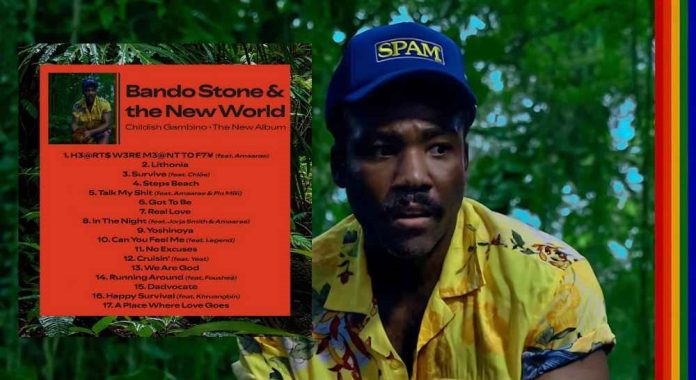Childish Gambino, the musical alter ego of Donald Glover, has always defied categorization. From his early mixtapes like I Am Just a Rapper—which blended pop culture satire with nerdy charm—to the genre-bending sounds of Awaken, My Love!, Glover has consistently used music to explore his complex identity. Now, with Bando Stone and the New World, billed as his final album under the Childish Gambino name, Glover aims to cap his musical journey with an ambitious, emotionally charged statement. But does the album live up to the high expectations he has set over the years?
Thematic Weight and Lyrical Depth
Bando Stone and the New World carries the weight of being Gambino’s supposed swan song. In interviews, Glover expressed that the process “wasn’t fulfilling” anymore, a sentiment that resonates throughout the album. Thematically, it explores identity, fame, and the fleeting nature of success. Tracks like “Lithonia” and “No Excuses” focus on Glover’s internal struggles, oscillating between self-doubt and bravado as he reflects on the challenge of maintaining authenticity in the public eye. While these themes have appeared in his earlier work, they feel more pointed here, as he contemplates closing the chapter on his public persona.
A Mixed Bag of Sonic Experimentation
Musically, the album blends genres—trap, jazz, punk, funk, and R&B—but at times, the fusion feels disjointed. The ambitious, glitch-heavy intro “H3@RT$ W3RE M3@NT T0 F7¥” tries to capture the chaotic energy of Kanye West’s Yeezus, but instead leans toward the dystopian sound of Donda, lacking urgency. As the album shifts between genres, some tracks feel more like exploratory sketches than fully realized compositions.
Not all the experiments fall flat, though. Songs like “Steps Beach,” co-produced with Steve Lacy, stand out with airy production and swooning falsettos. These moments allow Glover to showcase his romantic, soulful side. Similarly, “No Excuses” merges jazz influences with a rhythmic groove, adding depth to the album. Michael Uzowuru’s production, reminiscent of Frank Ocean’s Blonde, shines in these reflective moments.
Collaboration and Production
The album’s sound is largely shaped by collaborators like Uzowuru, Ludwig Göransson, and Steve Lacy. Uzowuru, known for working with Frank Ocean, brings a moody, introspective quality to tracks like “No Excuses,” where slow jazz instrumentation complements Gambino’s vocals. Göransson adds cinematic layers to songs like “In the Night” and “Real Love,” giving them a filmic feel.
However, not all collaborations hit the mark. Tracks like “Got to Be” and “Talk My Shit” feature Amaarae and Flo Milli but are weighed down by chaotic production, which dilutes their impact. Despite its ambition, the blend of sounds sometimes undermines the album’s emotional depth.
Controversy Among the Fanbase
Bando Stone and the New World has sparked mixed reactions from fans. Long-time listeners appreciate the complexity of Gambino’s sound and the emotional depth of his lyrics. Tracks like “Yoshinoya” bring back the nostalgic, rap-heavy vibe from his I Am Just a Rapper mixtape, which some fans love. However, the album’s uneven pacing and disjointed sound have left others unsatisfied.
The track “Yoshinoya” in particular has stirred debate. Some appreciate its lyrical cleverness, while others see it as emblematic of the album’s broader identity crisis. Gambino’s eclectic approach has always drawn both admiration and criticism, but the lack of cohesion here has made some question whether the album is an intentional artistic statement or an unfocused farewell.
A Fitting Farewell?
Music Industry Weekly recognizes that in the end, Bando Stone and the New World feels torn between ambition and finality. It aims to explore Childish Gambino’s musical and emotional range but often struggles under the weight of its purpose. In many ways, the album reflects Glover’s career—a complex, multi-layered project that resists easy classification. As a final album, however, it falls short of delivering the knockout punch fans had hoped for, leaving them to wonder if this truly is Gambino’s last musical chapter.








